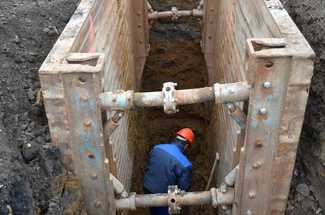Preventing A Deadly Trench Collapse
 Construction workers face danger nearly every moment of every shift. There are certain situations, however, that can prove more dangerous – more deadly – than others. Workers must take special care to prevent fatal accidents such as trench and excavation collapse.
Construction workers face danger nearly every moment of every shift. There are certain situations, however, that can prove more dangerous – more deadly – than others. Workers must take special care to prevent fatal accidents such as trench and excavation collapse.
Material excavation is fairly common in most construction projects and many large renovation projects. When the excavation becomes deeper than it is wide, it is considered a trench. If a trench reaches a depth of five feet or greater, a protective system must be put in place to ensure worker safety. A trench collapse can mean thousands of pounds of pressure piling up on construction workers in an instant. One cubic yard of dry topsoil weighs 2,000 pounds. Saturated, the same amount of soil weighs nearly 3,000 pounds. When this material comes crashing down on a worker, they have little time to react. The enormous weight can lead to catastrophic injuries or even death.
What Can Be Done To Prevent Disaster?
OSHA provides extensive notes and regulations focused on maintaining worker health and safety. Trench collapse and cave-ins are recognized as causing dozens of fatalities and hundreds of injuries each year. According to their documentation, the best protection is prevention.
- Protective systems: Whether using techniques such as sloping (cutting back a trench wall at an inclined angle) or physical systems (hydraulic shielding), it is best to recognize the danger and proactively act to counter it. Designing an appropriate system can be complex considering numerous factors such as soil classification, depth of cut, water content of soil and weather.
- Competent person: OSHA standards require that trenches must be inspected daily by a competent person – someone who can identify existing or potential hazards and who is authorized to take prompt corrective measures. This person will identify changing weather patterns, soil breakdown or new projects in the area that might be adding stress to the trench walls.
- Access points: Based on the size of the trench, numerous means of safe access and egress must be provided to all workers. These access points can be ladders, steps, ramps or other safe means of exit. For a trench that is four feet deep, an access point must be provided within 25 feet of all workers.
Unfortunately, construction sites will always be dangerous. From ladder falls to material collapse to safety equipment malfunction, workers face hazards at every turn. If you were injured or you lost a loved one in a construction accident, it is important to discuss your situation with an experienced attorney who can answer your most complex questions.
